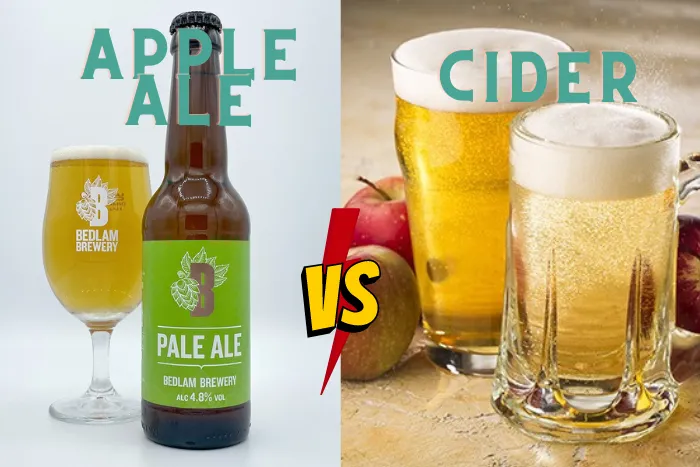Are you a beer enthusiast looking to explore apple ale vs cider? If you’re a beer enthusiast looking to explore the difference between apple ale and cider, this is your one-stop destination.
Two different drinks with their own stories and ingredients, production methods, flavors, and more, apple ales and ciders, have been around for centuries. In this blog post, we’ll talk about the history and health effects of apple ale and cider so you can make an informed choice.
So let’s dive in as we compare apple ale vs. cider – two different yet equally delicious beverages.
Table of Contents:
- Origins and History of Apple Ale and Cider
- Ingredients Used in Apple Ale and Cider
- Fermentation and Brewing Process for Apple Ale and Cider
- Flavor Profile, Color, Alcohol Content, IBU, and Health Impact of Apple Ale and Cider
- Popular Brands to Try Out for Apple Ale and Cider
- FAQs in Relation to Apple Ale vs Cider
- Conclusion
Origins and History of Apple Ale

Cider and ale crafted from apples have been brewed for centuries, with each variety boasting its distinct history. The first apple ale was made in England in the early Middle Ages.
The process involved fermenting apples, hops, water, and additional ingredients like spices or honey. This process created a sweet-tart beverage enjoyed by many throughout Europe and eventually spread to North America.
Origins and History Cider Beers
The origin of cider beer is slightly different than apple ale. Cider beer originated in France during the 16th century when brewers began adding yeast to fermented apples to create a carbonated alcoholic drink known as “cidre.”
Unlike traditional English ciders, which were still wines (non-carbonated), French ciders were sparkling beverages similar to champagne. This style of cider eventually spread across Europe and into North America, where it has become popular today.
Both drinks have had important historical significance over time. Apple sales have been used as currency during famines due to their high alcohol content and long shelf life. They are also enjoyed socially amongst friends and family members alike.
Ciders are often associated with special occasions such as weddings or holidays due to their refreshing taste and celebratory feel when shared among people who appreciate them most – craft beer enthusiasts.
Ingredients Used in Apple Ale and Cider
Common Ingredients in Apple Ale Beers:
Apple ale beers typically contain malted barley, hops, yeast, and apple juice. Barley malt is the base of most beers, imparting a sugary taste and body. Hops are added for bitterness and aroma.
Yeast is essential for the fermentation of sugars from the malt into alcohol. Lastly, apple juice adds a sweetness that helps balance the bitterness of the hops while adding a unique apple flavor to the beer.
Common Ingredients in Cider Beers
Cider beers use many of the same ingredients as regular ales but with one major difference – apples. Instead of using malted barley or wheat, cider beers are made with crushed apples or fresh-pressed apple juice, which provide sweetness without adding additional sugar during fermentation.
The addition of yeast will then help turn these sugars into alcohol, creating a delicious beverage that people worldwide have enjoyed for centuries.
Specialty Ingredients Used in Both
In addition to malts, hops, and yeast, special ingredients like spices, fruits, honey, or maple syrup can give each beer style its flavor profile. These ingredients can give each type of beer a unique taste and personality that sets it apart from the others.
The ingredients used in apple ale and cider beers vary greatly, but the end product is still delicious. Examining these two brews’ disparate fermentation and brewing methods, let us investigate how they vary.
Fermentation of Apple Ale
The fermentation process for apple ale beers differs slightly from cider beers. A special yeast strain is usually used to ferment apple ales and give them their unique flavor.
The fermentation temperature for apple ales typically falls within a range of 65-75°F (18-24°C) and usually takes about two weeks to complete. The fermentation of the beer can take approximately two weeks, contingent on the brewer’s recipe.
Fermentation of Cider Beer
When it comes to cider beers, they are fermented using wild yeasts or specially cultivated strains of yeast. Fermenting of cider beers happens at temperatures between 55-65°F (13-18°C).
This process can last up to four weeks or longer, with the sugars transforming into alcohol and CO2 while creating a sweet yet tart drink with an intricate flavor. The transformation of sugars into alcohol and carbon dioxide during the fermentation process produces a beverage that is both sweet and tangy, with an intricate taste.
Brewing Process for Aple Ale and Cider Beer

Brewing both types of beer requires similar processes, but with slight variations depending on what type you’re making: apple ale or cider beer. Generally, brewing involves mashing grains such as barley and wheat; boiling them with hops; cooling down the wort; adding yeast; transferring it into fermenters; allowing it to condition over several days/weeks until the desired taste is achieved; then packaging/bottling your finished product.
Brewers may opt for dry hopping during the conditioning phase of apple ales to boost hop aroma and flavor in their final product, a practice not often used when brewing ciders since apples provide enough natural sweetness without needing extra bittering agents like hops.
Some brewers add spices such as cinnamon and nutmeg during secondary fermentation or oak chips if they want woody notes in their results.
These differences ensure that each type has a unique character and appeal. Various options exist for the most discerning of tasters – from light and crisp Apple Ales to robust Cider Beers.
Flavor Profile, Color, Alcohol Content, IBU, and Health Impact of Apple Ale and Cider Beers
Two brews, apple ale and cider beer, exist with their own individual tastes, hues, ABV (alcohol by volume), IBU (International Bitterness Unit) levels and health implications. Despite having certain commonalities in the components used for production, there are also notable disparities between apple ale and cider beers.
Flavor Profile of Apple and Cider Beer
Apple ales offer a more intense flavor, usually with a slight sweetness, while ciders may vary from dry to somewhat sugary depending on the style. Cider is usually more tart than apple ale due to its higher acidity levels. In terms of color comparison between the two types of beer, both typically range from light golden hues for lighter varieties up through deep amber shades for darker ones.
Flavor Profile of Apple and Cider Beer
The alcohol content in both apple ales and ciders will vary depending on how strong each variety is brewed but generally speaking most commercial brands fall somewhere within 4%-8% ABV (alcohol by volume).
The IBU or International Bitterness Units measure how bitter a beer is based on its hop content; Apple Ales tend to have an IBU rating around 15-25 whereas ciders typically rate lower at 5-10 IBUs as hops are not traditionally used in making them.
Health Impact of Apple and Cider Beer
Finally, regarding the health impact comparison between the two types of beer, Apple Ale contains fewer calories per serving than regular lagers, so if you’re looking for something low-calorie, this might be your best bet.
Additionally, many people find that cider has less sugar than other alcoholic beverages, making it easier on their stomach after drinking. So if you’re trying to avoid a nasty hangover, this could be your go-to drink.
Before deciding which apple ale or cider to try, it’s important to consider the taste, color, ABV, IBU, and health benefits. Moving on from this comparison, we will look at some popular brands offering these two beer types.
Popular Brands to Try Out for Apple Ale and Cider Beers
There are many popular brands to choose from when it comes to apple ale and cider beers. There’s something for everyone, from crisp cider beer to sweet and tart apple ale. Here are some popular brands to try out for both types of beer:
Apple Ale Beers Brands
One popular brand is Angry Orchard Crisp Apple Ale. This beer has notes of fresh apples with a light body and dry finish. Strongbow Gold Apple Cider is another great choice. It tastes refreshingly crisp and has hints of honeydew melon and ripe pear. Lastly, Samuel Adams Stony Brook Red combines apples with cranberries for a unique take on this classic style.
Cider Brands
If you prefer ciders with a more traditional flavor profile, Magners Original Irish Cider has a lot of sweetness and tannins from genuine Irish apples for a truly memorable taste. Woodchuck Hard Cider Gumption might be your best bet if you want something sweeter.
It has flavors like citrus zest, clove spice, and wildflower honey that will make your taste buds dance. Lastly, if you want something really special, you could try Ace Joker Hard Apple Cider, which is a delicious drink made from different kinds of apples from Washington State.
These brands provide something unique that anyone who enjoys brews can enjoy, regardless of whether you’ve been drinking craft beers for a short time or your entire life. So why give one (or two) a try today?
FAQs in Relation to Apple Ale vs Cider
Are ale and cider the same?
No, ale and cider are not the same. Ale, a beer brewed with top-fermenting yeast, differs from cider, created by fermenting apple juice. Ales tend to be stronger than ciders in terms of alcohol content, and they often taste like malt or hops. Cider can range from sweet to dry depending on how much sugar was used during fermentation.
What are two reasons why we prefer to compare cider to wine rather than to beer?
1. Cider is crafted from the fermentation of fruits, while beer is brewed with grain-based components such as barley and wheat. This difference in the base ingredient means that cider has a more nuanced flavor profile than beer, making it better suited for comparison with wine.
2. Wine and cider’s fermentation and aging processes add complexity to their flavors, unlike beer’s simpler brewing process.
Why is cider better than beer?
Cider, with its lower alcohol and calorie content, is often seen as a healthier choice compared to beer. Its complex flavors come from fermented apples rather than barley or wheat. Cider’s lower bitterness makes it easier for craft beer novices.
Finally, cider goes well with spicy food and desserts, unlike beer. Thus, cider is considered a superior option to beer for numerous individuals due to its various aspects.
Conclusion
In conclusion, apple ale and cider beers have different origins, ingredients, methods, and flavors. Ciders are lighter than apple ales and have less alcohol by volume (ABV). Both offer distinct flavors that may differ depending on the brand. Regarding their health impacts, both types of beer contain some antioxidants. Still, they may also come with added sugar or preservatives, so check labels before consuming either beverage. When choosing between an apple ale and a cider beer, it is important to consider all these factors and personal taste preferences for the best drinking experience possible.
Please find the best apple ale and cider for your taste with our reviews, recommendations for equipment, subscription services, and tips for making your beer. Join us now to become an expert in craft beer!
Also See: Find Out the Nutritional Facts of Non-Alcoholic Beer
